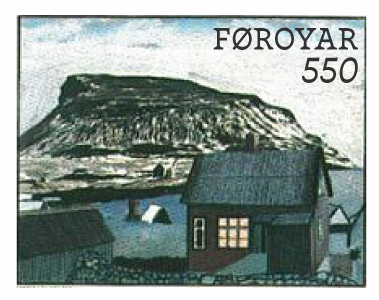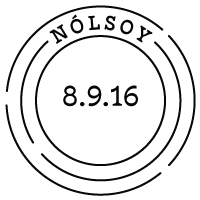Nólsoy · September 8th, 2016
A Visit to Nólsoy
For this issue of the Nordvest Tour Travelogue,
we bring an excerpt from the book Nordlandliebe, a
text written by Verena Stössinger.
“Alt er endnu i vorden.” Everything is still in progress: that is written on William Heinesen’s gravestone. And until everything is ready, at least here on these islands, no part of it is ever lost. And no one can escape anyone; and it’s not up for debate whether that is a good thing. “We can’t afford to choose if we like somebody or not,” a local writer told me when I asked about the constricted space, and the inescapable weight it gives to every word, every action. But at least for me — as someone without a history here who can just leave again — this also results in images and scenes that linger in my memory as though they were made up. Like the one from that Sunday afternoon.
I took the ferry to Nólsoy to meet with Emil Thomsen, an old publisher. I had arranged a visit, and I had been warned: he was less of a brainworker than a businessman; previously the Electrolux sales representative for these islands, he eventually acquired a printing press and started publishing literature both old and new. A sly fox with the memory of an aging elephant. Meanwhile, though, he was said to have gone deaf. So, after knocking on his front door a number of times, I decided just to enter the house.
An elderly woman welcomed me and led me into the dim living room. And there he was sitting on the bed, skinny and pale like a ghost, and he called out to me that he was ninety-two years old already, and wanted to live to be a hundred. Did I believe he would make it? I was happy to believe that, and was told to join him on his bed, sitting so close to him that he could touch me; as though he wanted to make sure I was real.
A TV set stood near the window, playing without sound; it was showing a western in black and white. On the table in the middle of the room I could make out a row of narrow, elongated objects; were they little metal parts? Or a collection of letter openers? The woman who had led me inside brought coffee.
“Oh!” called Emil Thomsen, “porcelæn!” as she set the Royal Danish cups down on the small folding table by his bed.
We had wienerbrød with the coffee, and he ate and drank and smoked all the while, forgetting each cigarette in the ashtray after three puffs. And then he started to sing: Lov o-hog Ta-hak og e-e-vi-hig Æære-he-e … I told him he sang beautifully, which I had to repeat three times until he understood what I said, whereupon he told me he had originally wanted to be a singer. He had traveled to Italy to study music but only made it as far as Pisa, for right there by the Leaning Tower he got the chance to buy three thousand pairs of silk stockings. And those sold “like hotcakes” back on the Faroes. But that was long ago, he said; he was now ninety-two years old, did I believe he would make it to one hundred? I still believed it, and he pointed in the direction of the table and said he now carved butter knives, the handles modeled after ancient designs. He had already made seventy-five of them, and once he reached a hundred he would start selling them at a thousand kroner apiece. To the tourists. The woman handed me one of the knives, I had to touch it, and then she called out to the man that I had come from Switzerland! From Switzerland!
“Switzerland,” he repeated as though he were chewing the word. And asked if I knew Oskar Bandle? Who was also from Switzerland; he knew him and had met him once, and I said: “Of course I know him, he was my professor at university.”
“How old is he?”
“I think he’s in his early eighties …”
“I am ninety-two!” called Emil Thomsen, “and I want to make it to one hundred! Do you think I will live to be one hundred?”
I believed it another time, and then the woman said it was handy that I knew Oskar Bandle, for he had left something behind on his last visit. Would I be able to take it back with me for him?
“What is it?” I asked.
“The books of Viderø and a sweater,” she said, and stood up and left the room. Emil Thomsen lit a cigarette and resumed singing. On TV, men were riding silently across a dusty plain. I heard the woman rummaging around in the next room, and after a while she came back with a large plastic bag, which she set down at my feet.
“This,” she said.
The bag contained a huge woolen sweater, white, with little brown dots and clearly hand-knit. With a turtleneck. It looked new. I thought about Oskar Bandle, a slight man who was by now living in a home for elderly people that surely had good heating, and I thought about my small suitcase.
“How long ago was that?” I asked the woman.
“Twenty years,” she said, and Emil Thomsen yelled: “Tak for besøget!” and lay down on the bed. I knew it was time for me to leave. And yet I had not even had a chance to voice my request: I was visiting because I needed his bank details; he owned the rights to a text we had translated and published. Bank details including SWIFT code and IBAN. Because he had never replied to our letters.

 Today’s entry in the #nordvesttour travelogue is an excerpt from Nordlandliebe (ed. Katharina Kienholz, Verlag Martin Wallimann, Alpnach / Switzerland 2009). The text is written by Verena Stössinger, and translated from the original German by her daughter, Nina Stössinger, with assistance from Caren Litherland.
The postage stamp from Nólsoy is typeset in Nina’s new typeface, and subject of The Nordvest Tour, Nordvest.
Today’s entry in the #nordvesttour travelogue is an excerpt from Nordlandliebe (ed. Katharina Kienholz, Verlag Martin Wallimann, Alpnach / Switzerland 2009). The text is written by Verena Stössinger, and translated from the original German by her daughter, Nina Stössinger, with assistance from Caren Litherland.
The postage stamp from Nólsoy is typeset in Nina’s new typeface, and subject of The Nordvest Tour, Nordvest.
